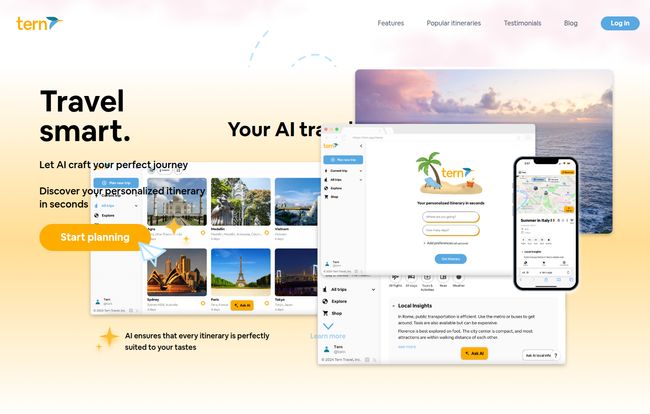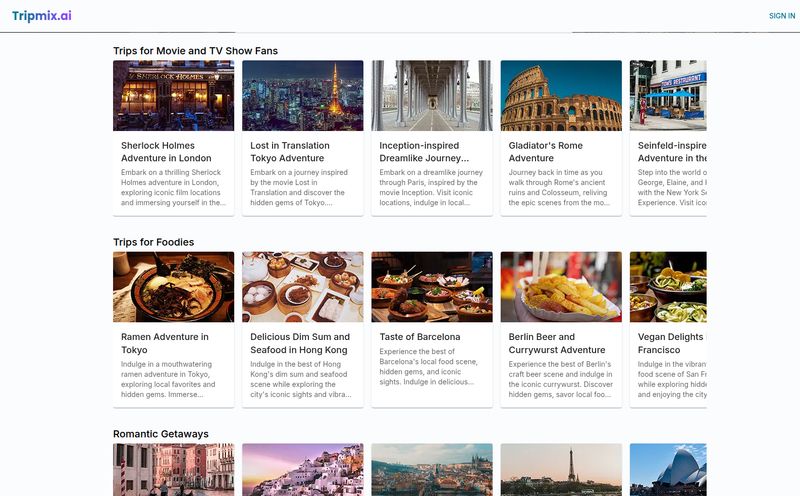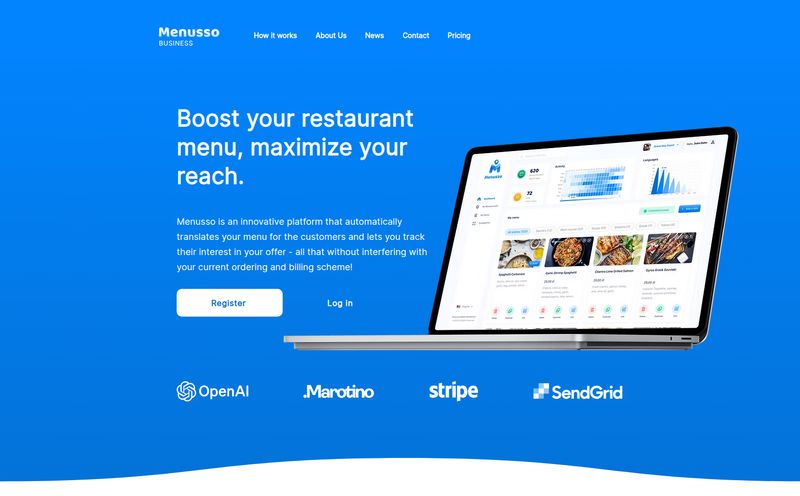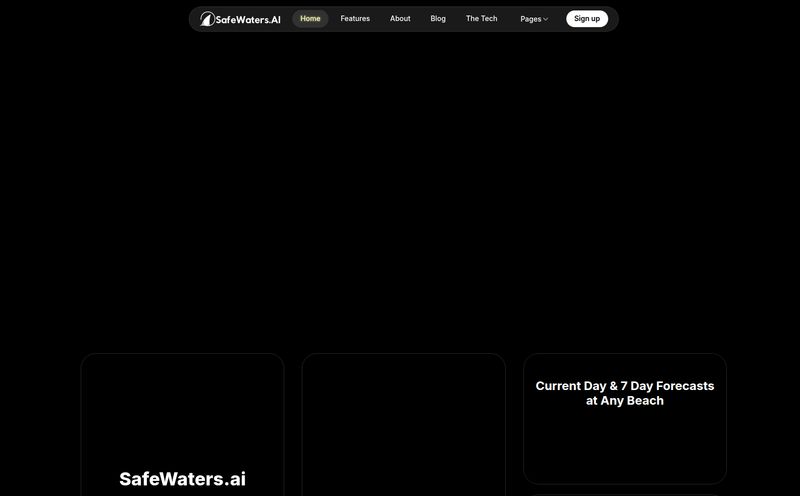Alright, let’s have a real chat. If you’ve spent more than five minutes in the digital marketing or tech space, you know AI is the word on everyone’s lips. It’s in our writing tools, our design software, and now, it’s coming for our vacations. And honestly? I was skeptical.
For years, my trip-planning process has been a carefully organized chaos of Google Docs, a million open browser tabs, and a dedicated spreadsheet that would make an accountant weep. It’s a ritual. So when another “game-changing” AI travel planner pops up, my default reaction is an eye-roll. But I kept hearing whispers about Tern, so I decided to put my crusty old methods aside and give it a whirl. Is it just another shiny object, or could this actually fix the headache of travel planning? Let's get into it.
So, What Exactly is Tern?
In a nutshell, Tern is an AI-powered travel planner designed to spit out a personalized itinerary in seconds. You feed it the basics: where you’re going, for how long, and what you’re into (e.g., museums, food, hiking, chilling on a beach). It then uses its AI brain to whip up a day-by-day plan, complete with activity suggestions, restaurant ideas, and even plots everything on a map for you. Think of it as a super-fast, slightly nerdy travel agent who lives in your browser.

Visit Tern
But it’s not just about spitting out a static list. The platform also has an integrated AI chat for tweaking your plan, collaboration features for those messy group trips, and direct links to book flights and hotels through partners. The idea is to be an all-in-one hub, from the first spark of an idea to the final booking confirmation.
My First Impressions: Getting Started with Tern
Signing up was painless. The first thing Tern did was ask me to take a “travel personality” quiz. My options were things like 'Savvy Spender', 'Beach Bum', and 'American Aficionado'. It's a clever bit of personalization, even if it feels a little broad. I picked a mix of culture and food focus, then plugged in a test trip: 5 days in Tokyo.
I hit enter and… wow. Okay, it was fast. Like, scary fast. In less time than it takes to boil a kettle, I had a full five-day itinerary. Day 1 was exploring Shinjuku, including the Gyoen National Garden and dinner in Omoide Yokocho. Day 2 was Harajuku and Shibuya, hitting the Meiji Shrine and the famous scramble crossing. It was… surprisingly solid. It wasn’t just a random list of top tourist spots; the days were grouped geographically, which is a rookie mistake I see people make all the time. Wasting half your day on a subway is not my idea of a vacation.
The initial plan was a fantastic starting point. A solid 80% of the work, done in 15 seconds. My spreadsheet method was starting to look a little… ancient.
The Standout Features (That Actually Matter)
A tool can have a million features, but only a few really make a difference. Here’s what stood out to me during my test drive.
The AI Itinerary Generator: Your Personal Travel Agent?
This is the core of Tern. The quality of the initial itinerary is impressive for a free tool. It correctly identified logical neighborhood clusters and a good mix of activities. For a popular destination like Tokyo, it absolutely nailed the fundamentals. It even suggested specific subway lines to take. I can see this being a lifesaver for anyone who gets overwhelmed by the sheer volume of options when planning a trip to a major city. It cuts through the noise immediately.
Visualizing Your Trip on a Map
This might be my favorite feature. Every single suggestion—from the hotel to the tiny ramen shop—is plotted on a map right next to your itinerary. This is a game-changer for logistics. You can instantly see if your afternoon plan is realistic or if you’ve accidentally scheduled back-to-back activities on opposite sides of the city. It turns an abstract list of names into a concrete, walkable plan. For a visual planner like me, this is gold.
Chat with AI: Fine-Tuning on the Fly
The first draft of any plan is never perfect, right? Tern has an “Ask AI” chat feature to make adjustments. I tried it out. “Can you replace the Robot Restaurant with something more focused on traditional art?” I typed. It suggested the Nezu Museum and updated the itinerary. Then I tried, “Find me a great spot for vegetarian ramen near Shibuya station.” It popped a few options right into the plan. It’s much faster than opening ten new tabs and searching “best veggie ramen shibuya” on Google. I found it worked best for specific, direct requests.
Group Travel Without the Group Chat Headache
We’ve all been there. That endless group chat to plan a simple weekend trip. Who’s booking what? Does everyone agree on the hotel? It’s a nightmare. Tern’s collaboration feature lets you invite friends to view and edit the itinerary directly. They can add suggestions, comment on activities, and see the plan come together in one place. It brings the collaborative spirit of Google Docs to travel planning, which could genuinely save friendships. Seriously.
From Plan to Plane: Integrated Bookings
Once your itinerary is set, Tern provides links to book your flights, hotels, and even some activities. It’s important to know that Tern isn’t a travel agency itself; it partners with big names like Booking.com, Kayak, Expedia, and Viator. When you click to book, you’re redirected to their site. It's a smooth integration and it makes sense from a business perspective. More on that in a second.
The Not-So-Perfect Parts (Let's Be Real)
No tool is perfect, and Tern is no exception. While I was mostly impressed, there are a few things to keep in mind.
First, the AI isn’t a mind reader. If you have super niche interests, you’ll probably have to do some manual tweaking. I asked it for “a place that specializes in vintage 1970s Japanese synthesizers” and it gave me a generic electronics store. It’s fantastic for the 80-90% of popular travel, but for the truly obscure stuff, you’ll still need to do your own digging.
Second, its reliance on partners for bookings means you’re limited to their inventory. This isn’t a huge problem since they partner with the biggest players in the game, but if you’re loyal to a specific hotel chain that isn't on their platform or prefer boutique booking sites, you'll have to book separately. Also, it’s a web-based tool that relies on JavaScript, so no offline mode if you were hoping to use it on the plane.
How Does Tern Make Money If It's Free?
This is the question every good SEO and marketer asks. The FAQ on their site asks “Is it free?” but doesnt give a direct answer. From my analysis, the answer seems to be yes, the planning tool is free to use. Tern makes its money through affiliate commissions. When you click a link to book a hotel on Booking.com or a tour on Viator through their platform, Tern gets a small kickback from that company. It’s a classic, effective business model, and it means the core planning service can remain free for us users. It’s a win-win, and it's a transparent model I can get behind.
So, Who is Tern Really For?
After playing around with it for a while, I have a pretty good idea of who would love this tool:
- The Overwhelmed Planner: If you get stressed out by endless choices and just want a solid starting point, Tern is your new best friend.
- The Group Trip Organizer: If you’re the designated planner for your friends or family, the collaboration feature will save you so much time and sanity.
- The Weekend Warrior: Planning a quick 3-day trip to a new city? Tern will get you a functional plan in minutes, letting you spend more time packing and less time stressing.
- The Visual Planner: If you think in terms of maps and logistics, the map view is an absolute killer feature.
However, if you're an expert-level travel hacker with a complex system of award points and obscure booking sites, or you exclusively travel to off-the-beaten-path destinations with little online presence, you might find it a bit basic. It’s a tool for the 90%, not a replacement for deep, specialized expertise.
Frequently Asked Questions about Tern
1. Is the Tern AI travel planner actually free to use?
Yes, the itinerary planning features are free. The platform earns money through affiliate partnerships when you book flights, accommodations, or tours through the links they provide.
2. How is Tern different from just using ChatGPT?
While you can ask ChatGPT to build an itinerary, Tern offers a much more integrated experience. It provides a dedicated user interface, visualizes everything on a map, allows for easy collaboration, and connects directly to booking platforms. It's a specialized tool, not a general-purpose chatbot.
3. Can I collaborate with friends who don't have a Tern account?
Yes, you can share a unique link to your itinerary. This allows others to view the plan and, with the right permissions, suggest edits or add comments, making group planning much easier.
4. How accurate are the AI recommendations?
For popular destinations and common interests, the recommendations are surprisingly accurate and well-organized. For very niche or specific requests, the AI may struggle and provide more generic suggestions, requiring some manual adjustment.
5. Can I use Tern on my phone?
Tern is a web-based platform that is mobile-friendly, so you can access and edit your itineraries from your phone's browser. It's not a native app, but it works well on the go as long as you have an internet connection.
6. What happens if I don't like a suggestion?
You can easily delete any suggestion from the itinerary or use the AI chat to ask for an alternative. For example, you can ask for a “cheaper restaurant” or a “less touristy museum” and it will update the plan.
My Final Verdict on Tern
I came in a skeptic and I'm walking away genuinely impressed. Tern isn’t going to replace the joy of discovering a hidden gem on your own, but it masterfully handles the most tedious parts of travel planning. It takes the 10 hours of chaotic research and condenses it into a 10-minute task, giving you a beautiful, functional, and collaborative blueprint for your trip.
It’s not perfect, but it doesn’t have to be. Its purpose is to get you 80% of the way there, and it does that brilliantly. For my next quick city break, will I fire up my old, clunky spreadsheet? Honestly, probably not. I think I’ll give Tern the first shot. And for a cynical old-school planner like me, that’s saying a lot.



